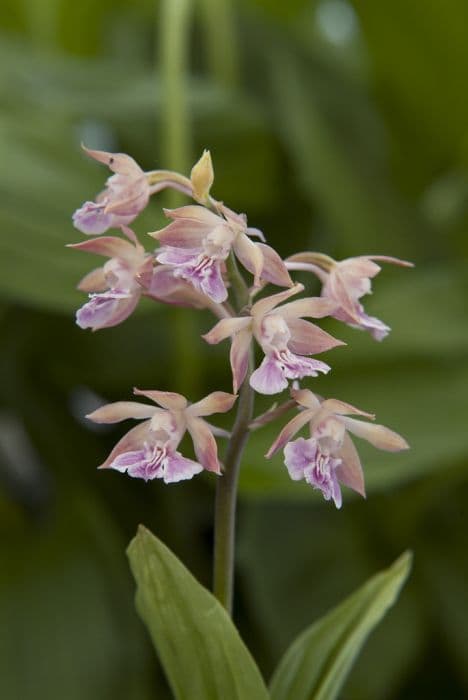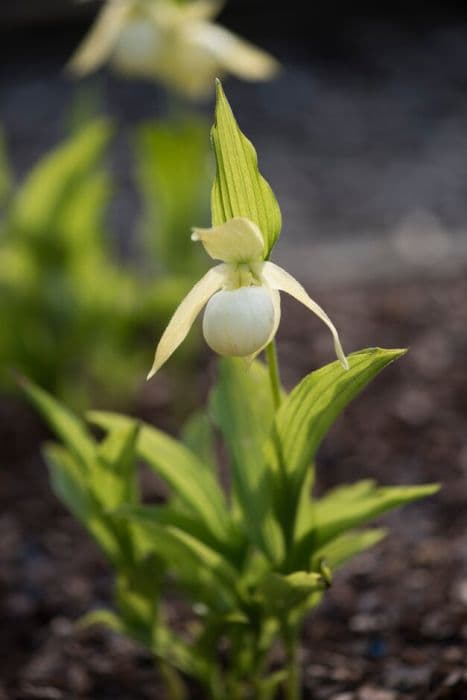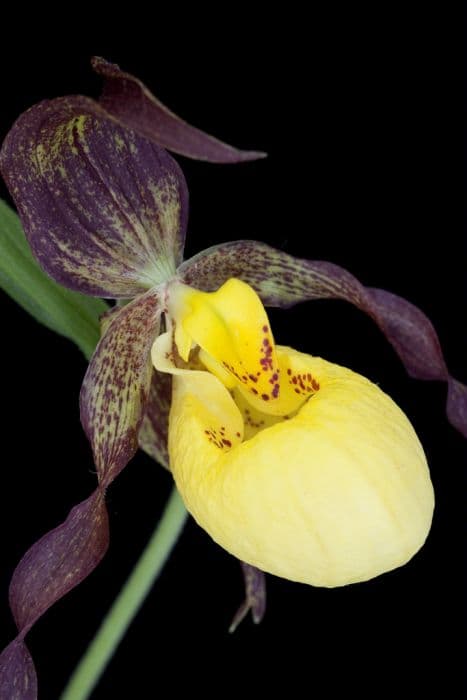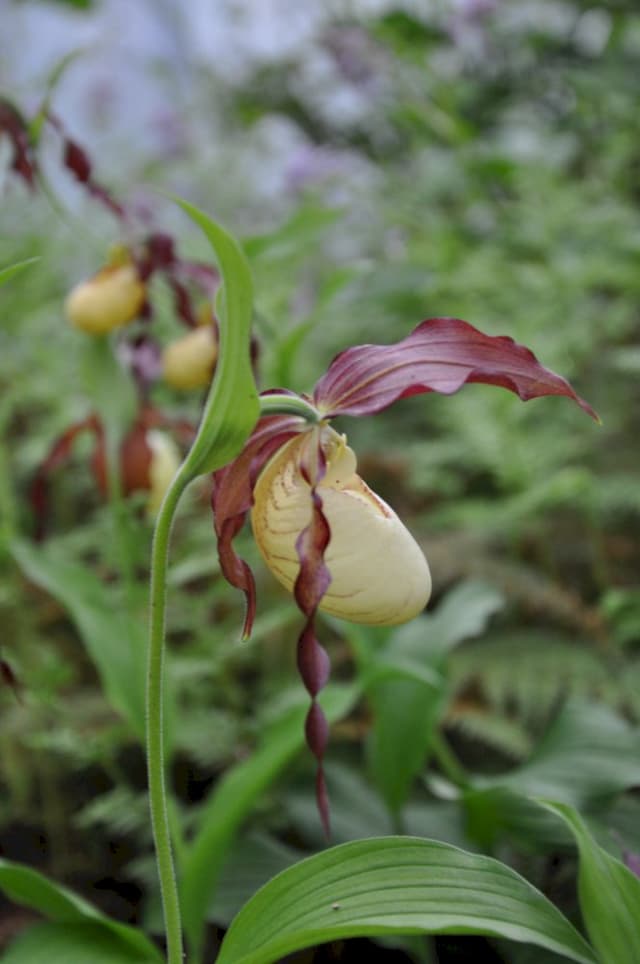Tongariro Orchid Pleione Tongariro gx

ABOUT
The Pleione Tongariro, commonly known as the Windowsill Orchid, presents a striking and vivid appearance, typically favored by orchid enthusiasts for its ornate and colorful flowers. Blooming mainly in the spring, this plant showcases blossoms that are a vibrant mix of pink and purple hues, often with a mesmerizing gradient effect and a central portion that can display a deeper, more intense coloration or intricate patterning. The flowers themselves tend to be large in comparison to the plant, with each petal displaying a delicate texture that can range from smooth to slightly ruffled. The Windowsill Orchid's leaves are slender and elongated, typically presenting a fresh, verdant green that complements the brightness of the blooms. The foliage may have a slightly pleated appearance, adding to the overall elegance of the plant. It's important to note that as an orchid, the Pleione Tongariro has a distinct growth habit, with each flower emerging from a single pseudobulb, a storage organ that helps the plant survive periods when it is not in active growth. After flowering, this plant may enter a dormancy phase where the leaves die back, and it conserves energy until the next growing season. The overall visual appeal of the Pleione Tongariro is one of exotic beauty and is highly regarded for its showy flowers that can add a burst of life to any indoor garden or windowsill display.
About this plant
 Names
NamesFamily
Orchidaceae.
Synonyms
Windowsill Orchid, Indian Crocus.
Common names
Pleione Tongariro gx.
 Toxicity
ToxicityTo humans
The Pleione Tongariro, more commonly known as Pleione, has not been widely documented for its toxicity to humans. However, as a precaution, it should be treated like other orchids which typically are not considered highly toxic. If ingested, it might cause mild stomach upset or irritation of the mouth and throat. It is always advisable to avoid ingestion of any plant parts if their toxicity is uncertain, to prevent any possible adverse effects.
To pets
The Pleione Tongariro, referred to simply as Pleione, is not generally known for being toxic to pets. Similar to the precaution in humans, since there is no specific information on its toxicity to animals, it should be handled with care. Many orchids are non-toxic to pets, but if a pet were to ingest part of the plant, they might experience mild digestive discomfort. If any symptoms arise after ingestion, it is best to consult a veterinarian.
 Characteristics
CharacteristicsLife cycle
Perennials
Foliage type
Deciduous
Color of leaves
Green
Flower color
Mixed
Height
1 foot (30 cm)
Spread
1 foot (30 cm)
Plant type
Bulb
Hardiness zones
9
Native area
Asia
Benefits
 General Benefits
General Benefits- Aesthetic Appeal: Pleione Tongariro, commonly known as the orchid, adds stunning beauty to gardens and homes with its vibrant flowers and unique shape.
- Easy to Grow: This orchid is known for being relatively easy to grow, with some species adaptable to indoor container gardening.
- Seasonal Interest: Its blooming season brings a pop of color in spring, breaking the monotony of winter and signaling the change of seasons.
- Compact Size: Pleione Tongariro has a compact growth habit, making it suitable for gardeners with limited space.
- Gift Potential: Due to its beauty, the orchid often makes a delightful gift for plant enthusiasts and those who appreciate natural decor.
 Medical Properties
Medical PropertiesThis plant is not used for medical purposes.
 Air-purifying Qualities
Air-purifying QualitiesThis plant is not specifically known for air purifying qualities.
 Other Uses
Other Uses- Pleione Tongariro, commonly known as the Windowsill Orchid, can be used in photography and art projects due to its striking blooms offering a vivid subject for artists and photographers seeking to capture the beauty of nature.
- In terrariums, Windowsill Orchids can add a layer of exotic charm due to their smaller size and ornamental appeal, making them suitable for enclosed miniature garden displays.
- Culinary presentations occasionally employ the flowers of Windowsill Orchids as decorative, non-toxic garnishes for desserts and cocktails, adding a touch of elegance.
- The Windowsill Orchid’s vibrant flowers can also be used in educational settings, such as biology classrooms, to teach students about plant biology and reproduction through observing the lifecycle of an orchid.
- As a symbol of luxury and delicate beauty, the Windowsill Orchid can be used in various events like weddings or high-end product launches to create an ambiance of sophistication.
- In crafting, the flowers can be carefully pressed and preserved to be used in making bookmarks or embellishing handmade greeting cards.
- Windowsill Orchids can be implemented in fashion design, where the flowers might inspire patterns, prints, or even be used in making of botanical jewelry or accessories.
- Festival and ceremony spaces sometimes incorporate live Windowsill Orchids to bring bursts of color and liveliness to the decor, especially in spring-themed events.
- Windowsill Orchids can be presented as special, living gifts representing rarity and appreciation, particularly to plant enthusiasts who appreciate the uniqueness of orchids.
- In an office or academic setting, maintaining a blooming Windowsill Orchid can be a visual reminder of growth and periods of flourishing, offering a moment of tranquility amidst busy workdays.
Interesting Facts
 Feng Shui
Feng ShuiThe Orchid is not used in Feng Shui practice.
 Zodiac Sign Compitability
Zodiac Sign CompitabilityThe Orchid is not used in astrology practice.
 Plant Symbolism
Plant Symbolism- Rebirth and Renewal: Pleione, often referred to as the "Windowsill Orchid," represents rebirth and renewal due to its ability to bloom annually with stunning flowers from what appears to be a lifeless bulb.
- Beauty and Refinement: As a member of the orchid family, the Windowsill Orchid symbolizes beauty, refinement, and elegance, reflecting its delicate and ornate flowers.
- Rare and Precious: The rarity of the Pleione Tongariro gx cultivar conveys a sense of preciousness and value, often making it a symbol of exclusivity and uniqueness.
- Overcoming Challenges: The orchid's capacity to grow in challenging conditions is symbolic of overcoming difficulties and blooming beautifully against the odds.
 Water
WaterThe orchid, commonly known as Pleione, requires careful watering to thrive. During the growing season, typically spring to early summer, water the plant every 5 to 7 days with approximately 4 ounces of water each time, ensuring that the potting medium is evenly moist but not saturated. In the dormant period, which is after the flowers have died back, reduce watering frequency to once every 10 to 14 days, providing just enough moisture to prevent the mix from completely drying out. Always use lukewarm water and avoid getting water on the leaves to minimize the risk of fungal diseases.
 Light
LightPleione orchids prefer bright, indirect light with some dappled morning sun. They thrive best when placed near an east-facing window where they can receive some early sunlight without the harsh midday rays. Avoid intense, direct afternoon sun as it can scorch the delicate leaves of the Pleione.
 Temperature
TemperaturePleiones thrive in moderate temperature conditions, with an ideal range between 55 and 75 degrees Fahrenheit. They can tolerate a maximum temperature of about 80 degrees Fahrenheit and a minimum of around 40 degrees Fahrenheit, but prolonged exposure outside of the ideal range can stress the plant.
 Pruning
PruningPrune Pleiones after flowering by removing spent flowers to encourage new growth. The best time for pruning is when the flowers have wilted and the plant begins to enter its dormancy period. This typically occurs annually and thorough pruning can help stimulate the next season's growth.
 Cleaning
CleaningAs needed
 Soil
SoilThe best soil mix for Pleione Tongariro, commonly known as the "Windowsill Orchid," is a well-draining, airy mix such as a blend of fine bark chips, perlite, and sphagnum moss. The soil pH should ideally be slightly acidic, around 5.5 to 6.5.
 Repotting
RepottingWindowsill Orchids should be repotted every one to two years or when the medium has broken down. It's best to repot after flowering, when new growth appears.
 Humidity & Misting
Humidity & MistingWindowsill Orchids thrive in high humidity, generally between 60% to 80%. A pebble tray or humidifier can help maintain the ideal conditions.
 Suitable locations
Suitable locationsIndoor
Provide bright, indirect light and high humidity indoors.
Outdoor
Place in dappled sunlight, shelter from strong winds.
Hardiness zone
9-10 USDA
 Life cycle
Life cyclePleione 'Tongariro', commonly referred to as the Tongariro orchid, begins its life cycle as a pseudobulb, a storage organ that contains the nutrients necessary for the plant's growth. From the pseudobulb, a single leaf emerges, which photosynthesizes to generate energy for the plant's development. Following the growth of the leaf, the plant produces a flower stalk, typically blooming with one or more flowers in the spring. After pollination, the flowers may produce seed capsules containing countless tiny seeds, which disperse and can potentially grow into new plants if they land in suitable conditions. Meanwhile, the pseudobulb begins to wither and a new pseudobulb forms, ensuring the plant's survival for the next season. Once the flowering and seed dispersal stages are complete, the plant enters a period of dormancy, during which it conserves energy before restarting the cycle with the growth of a new leaf the following year.
 Propogation
PropogationPropogation time
Spring-Early Summer
Propogation: Pleione Tongariro, commonly known as the Tongariro orchid, is best propagated by dividing pseudobulbs, a method that is most effectively carried out during the plant's dormancy period, typically after the foliage has withered which is usually in late autumn. To propagate the Tongariro orchid, carefully unearth the pseudobulbs from the substrate, ensuring minimal damage to the structures. Select healthy and mature pseudobulbs and detach them from the parent clump. These bulbs will often have developed small, adventitious buds known as back bulbs that can be used to propagate new plants. Make sure that each division has at least one good pseudobulb with roots attached for better chances of successful growth. The divided pseudobulbs can then be potted individually in well-draining orchid compost, placed at a depth where the top of the bulb is level with the compost surface. Provide bright, indirect light and maintain moderate moisture to encourage the new growth in the upcoming growing season.









